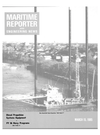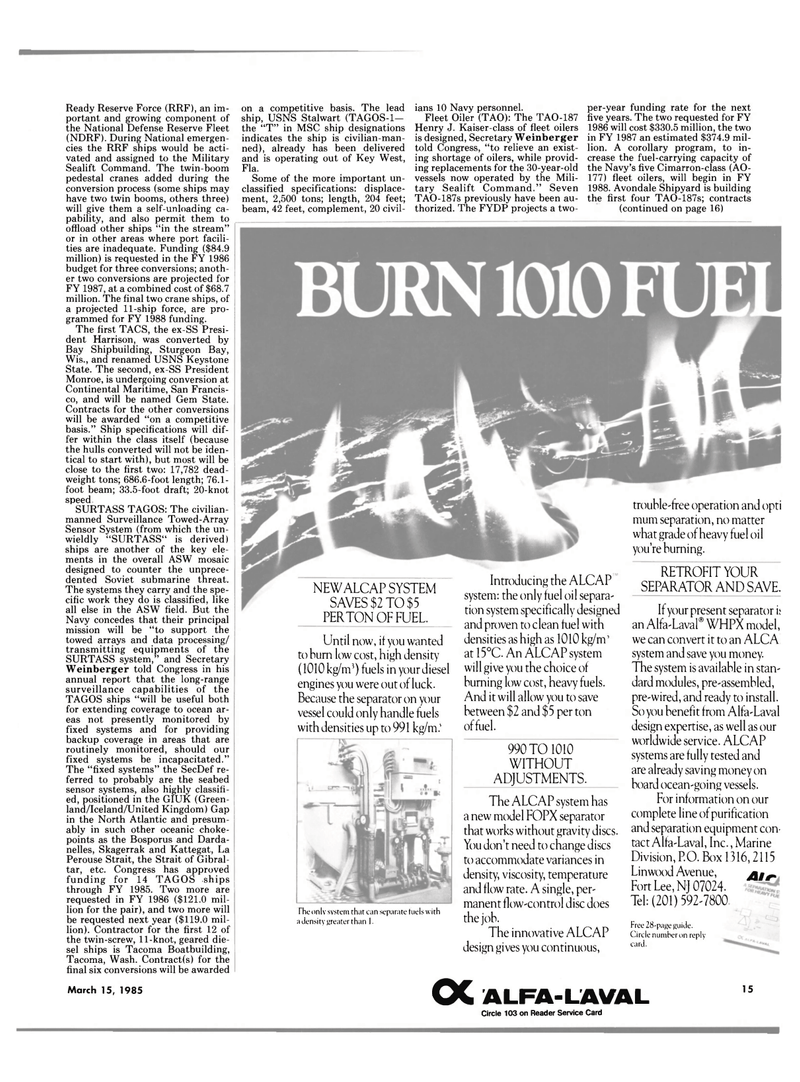
Page 13: of Maritime Reporter Magazine (March 15, 1985)
Read this page in Pdf, Flash or Html5 edition of March 15, 1985 Maritime Reporter Magazine
Ready Reserve Force (RRF), an im- portant and growing component of the National Defense Reserve Fleet (NDRF). During National emergen- cies the RRF ships would be acti- vated and assigned to the Military
Sealift Command. The twin-boom pedestal cranes added during the conversion process (some ships may have two twin booms, others three) will give them a self-unloading ca- pability, and also permit them to offload other ships "in the stream" or in other areas where port facili- ties are inadequate. Funding ($84.9 million) is requested in the FY 1986 budget for three conversions; anoth- er two conversions are projected for
FY 1987, at a combined cost of $68.7 million. The final two crane ships, of a projected 11-ship force, are pro- grammed for FY 1988 funding.
The first TACS, the ex-SS Presi- dent Harrison, was converted by
Bay Shipbuilding, Sturgeon Bay,
Wis., and renamed USNS Keystone
State. The second, ex-SS President
Monroe, is undergoing conversion at
Continental Maritime, San Francis- co, and will be named Gem State.
Contracts for the other conversions will be awarded "on a competitive basis." Ship specifications will dif- fer within the class itself (because the hulls converted will not be iden- tical to start with), but most will be close to the first two: 17,782 dead- weight tons; 686.6-foot length; 76.1- foot beam; 33.5-foot draft; 20-knot speed
SURTASS TAGOS: The civilian- manned Surveillance Towed-Array
Sensor System (from which the un- wieldly "SURTASS" is derived) ships are another of the key ele- ments in the overall ASW mosaic designed to counter the unprece- dented Soviet submarine threat.
The systems they carry and the spe- cific work they do is classified, like all else in the ASW field. But the
Navy concedes that their principal mission will be "to support the towed arrays and data processing/ transmitting equipments of the
SURTASS system," and Secretary
Weinberger told Congress in his annual report that the long-range surveillance capabilities of the
TAGOS ships "will be useful both for extending coverage to ocean ar- eas not presently monitored by fixed systems and for providing backup coverage in areas that are routinely monitored, should our fixed systems be incapacitated."
The "fixed systems" the SecDef re- ferred to probably are the seabed sensor systems, also highly classifi- ed, positioned in the GIUK (Green- land/Iceland/United Kingdom) Gap in the North Atlantic and presum- ably in such other oceanic choke- points as the Bosporus and Darda- nelles, Skagerrak and Kattegat, La
Perouse Strait, the Strait of Gibral- tar, etc. Congress has approved funding for 14 TAGOS ships through FY 1985. Two more are requested in FY 1986 ($121.0 mil- lion for the pair), and two more will be requested next year ($119.0 mil- lion). Contractor for the first 12 of the twin-screw, 11-knot, geared die- sel ships is Tacoma Boatbuilding,
Tacoma, Wash. Contract(s) for the final six conversions will be awarded
March 15, 1985 on a competitive basis. The lead ship, USNS Stalwart (TAGOS-1— the "T" in MSC ship designations indicates the ship is civilian-man- ned), already has been delivered and is operating out of Key West,
Fla.
Some of the more important un- classified specifications: displace- ment, 2,500 tons; length, 204 feet; beam, 42 feet, complement, 20 civil- ians 10 Navy personnel.
Fleet Oiler (TAO): The TAO-187
Henry J. Kaiser-class of fleet oilers is designed, Secretary Weinberger told Congress, "to relieve an exist- ing shortage of oilers, while provid- ing replacements for the 30-year-old vessels now operated by the Mili- tary Sealift Command." Seven
TAO-187s previously have been au- thorized. The FYDP projects a two- per-year funding rate for the next five years. The two requested for FY 1986 will cost $330.5 million, the two in FY 1987 an estimated $374.9 mil- lion. A corollary program, to in- crease the fuel-carrying capacity of the Navy's five Cimarron-class (AO- 177) fleet oilers, will begin in FY 1988. Avondale Shipyard is building the first four TAO-187s; contracts (continued on page 16)
NEW ALCAP SYSTEM
SAVES $2 TO $5
PER TON OF FUEL.
Until now, if you wanted to bum low cost, high density (1010kg/m3) fuels in yourdiesel engines you were out of luck.
Because the separator on your vessel could only handle fuels with densities up to 991 kg/m.1
I heonh system that can separate fuels with a density greater than 1.
Introducing the ALCAP system: the only fuel oil separa- tion system specifically designed and proven to clean tuel with densities as high as 1010 kg/rrf at 15°C. An ALCAP system will give you the choice of burning low cost, heavy fuels.
And it will allow you to save between $2 and $5 per ton of fuel. 990 TO 1010
WITHOUT
ADJUSTMENTS.
The ALCAP system has a new model FOPX separator that works without gravity discs.
You don't need to change discs to accommodate variances in density, viscosity, temperature and flow rate. A single, per- manent flow-control disc does the job.
The innovative ALCAP design gives you continuous, trouble-free operation and opti mum separation, no matter what grade of heavy fuel oil you're burning.
RETROFIT YOUR
SEPARATOR AND SAVE.
If your present separator i; an Alfa-LavafWHPX model, we can convert it to an ALCA system and save you money.
The system is available in stan- dard modules, pre-assembled, pre-wired, and ready to install.
So you benefit from Alfa-Laval design expertise, as well as our worldwide service. ALCAP systems are fully tested and are already saving money on board ocean-going vessels.
For information on our complete line of purification and separation equipment con- tact Alfa-Laval, Inc., Marine
Division, P.O. Box 1316,2115
Linwood Avenue, Alr~
Fort Lee, NJ 07024.
Tel: (201) 592-7800
Free 28-page guide.
Circle number on reply card.
OC ALFA-LAVAL
Circle 103 on Reader Service Card 15

 12
12

 14
14
